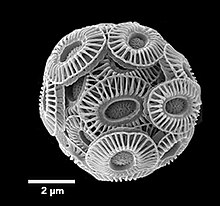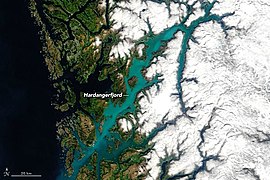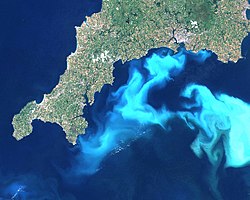| This article includes a list of general references, but it lacks sufficient corresponding inline citations. Please help to improve this article by introducing more precise citations. (April 2012) (Learn how and when to remove this message) |
| Gephyrocapsa huxleyi | |
|---|---|

| |
| A scanning electron micrograph of a single G. huxleyi cell | |
| Scientific classification | |
| Domain: | Eukaryota |
| Clade: | Diaphoretickes |
| Phylum: | Haptista |
| Subphylum: | Haptophytina |
| Class: | Coccolithophyceae |
| Order: | Isochrysidales |
| Family: | Noelaerhabdaceae |
| Genus: | Gephyrocapsa |
| Species: | G. huxleyi |
| Binomial name | |
| Gephyrocapsa huxleyi (Lohmann) P.Reinhardt, 1972 | |
| Synonyms | |
| |

Gephyrocapsa huxleyi, formerly called Emiliania huxleyi, is a species of coccolithophore found in almost all ocean ecosystems from the equator to sub-polar regions, and from nutrient rich upwelling zones to nutrient poor oligotrophic waters. It is one of thousands of different photosynthetic plankton that freely drift in the photic zone of the ocean, forming the basis of virtually all marine food webs. It is studied for the extensive blooms it forms in nutrient-depleted waters after the reformation of the summer thermocline. Like other coccolithophores, E. huxleyi is a single-celled phytoplankton covered with uniquely ornamented calcite disks called coccoliths. Individual coccoliths are abundant in marine sediments although complete coccospheres are more unusual. In the case of E. huxleyi, not only the shell, but also the soft part of the organism may be recorded in sediments. It produces a group of chemical compounds that are very resistant to decomposition. These chemical compounds, known as alkenones, can be found in marine sediments long after other soft parts of the organisms have decomposed. Alkenones are most commonly used by earth scientists as a means to estimate past sea surface temperatures.
Basic facts
Emiliania huxleyi was named after Thomas Huxley and Cesare Emiliani, who were the first to examine sea-bottom sediment and discover the coccoliths within it. It is believed to have evolved approximately 270,000 years ago from the older genus Gephyrocapsa Kampter and became dominant in planktonic assemblages, and thus in the fossil record, approximately 70,000 years ago. It is the most numerically abundant and widespread coccolithophore species. The species is divided into seven morphological forms called morphotypes based on differences in coccolith structure (See Nannotax for more detail on these forms). Its coccoliths are transparent and commonly colourless, but are formed of calcite which refracts light very efficiently in the water column. This, and the high concentrations caused by continual shedding of their coccoliths makes E. huxleyi blooms easily visible from space. Satellite images show that blooms can cover areas of more than 10,000 km, with complementary shipboard measurements indicating that E. huxleyi is by far the dominant phytoplankton species under these conditions. This species has been an inspiration for James Lovelock's Gaia hypothesis which claims that living organisms collectively self-regulate biogeochemistry and climate at nonrandom metastable states.
Abundance and distribution
Emiliania huxleyi is considered a ubiquitous species. It exhibits one of the largest temperature ranges (1–30 °C) of any coccolithophores species. It has been observed under a range of nutrient levels from oligotrophic (subtropical gyres) to eutrophic waters (upwelling zones/ Norwegian fjords). Its presence in plankton communities from the surface to 200m depth indicates a high tolerance for both fluctuating and low light conditions. This extremely wide tolerance of environmental conditions is believed to be explained by the existence of a range of environmentally adapted ecotypes within the species. As a result of these tolerances its distribution ranges from the sub-Arctic to the sub-Antarctic and from coastal to oceanic habitats. Within this range it is present in nearly all euphotic zone water samples and accounts for 20–50% or more of the total coccolithophore community.
During massive blooms (which can cover over 100,000 square kilometers), E. huxleyi cell concentrations can outnumber those of all other species in the region combined, accounting for 75% or more of the total number of photosynthetic plankton in the area. E. huxleyi blooms regionally act as an important source of calcium carbonate and dimethyl sulfide, the massive production of which can have a significant impact not only on the properties of the surface mixed layer, but also on global climate. The blooms can be identified through satellite imagery because of the large amount of light back-scattered from the water column, which provides a method to assess their biogeochemical importance on both basin and global scales. These blooms are prevalent in the Norwegian fjords, causing satellites to pick up "white waters", which describes the reflectance of the blooms picked up by satellites. This is due to the mass of coccoliths reflecting the incoming sunlight back out of the water, allowing the extent of E. huxleyi blooms to be distinguished in fine detail.
Extensive E. huxleyi blooms can have a visible impact on sea albedo. While multiple scattering can increase light path per unit depth, increasing absorption and solar heating of the water column, E. huxleyi has inspired proposals for geomimesis, because micron-sized air bubbles are specular reflectors, and so in contrast to E. huxleyi, tend to lower the temperature of the upper water column. As with self-shading within water-whitening coccolithophore plankton blooms, this may reduce photosynthetic productivity by altering the geometry of the euphotic zone. Both experiments and modeling are needed to quantify the potential biological impact of such effects, and the corollary potential of reflective blooms of other organisms to increase or reduce evaporation and methane evolution by altering fresh water temperatures.
Biogeochemical impacts
| This section does not cite any sources. Please help improve this section by adding citations to reliable sources. Unsourced material may be challenged and removed. (March 2024) (Learn how and when to remove this message) |
Climate change
As with all phytoplankton, primary production of E. huxleyi through photosynthesis is a sink of carbon dioxide. However, the production of coccoliths through calcification is a source of CO2. This means that coccolithophores, including E. huxleyi, have the potential to act as a net source of CO2 out of the ocean. Whether they are a net source or sink and how they will react to ocean acidification is not yet well understood.
Ocean heat retention
Scattering stimulated by E. huxleyi blooms not only causes more heat and light to be pushed back up into the atmosphere than usual, but also cause more of the remaining heat to be trapped closer to the ocean surface. This is problematic because it is the surface water that exchanges heat with the atmosphere, and E. huxleyi blooms may tend to make the overall temperature of the water column dramatically cooler over longer time periods. However, the importance of this effect, whether positive or negative, is currently being researched and has not yet been established.
Gallery
-
 Landsat image of a 1999 E. huxleyi bloom in the English Channel off Cornwall.
Landsat image of a 1999 E. huxleyi bloom in the English Channel off Cornwall.
-
 E. huxleyi bloom in the Barents Sea.
E. huxleyi bloom in the Barents Sea.
See also
- CLAW hypothesis
- Dimethylsulfoniopropionate
- Emiliania huxleyi virus 86, a marine virus that infects E. huxleyi
Notes
- Reinhardt, P. (1972). Coccolithen. Kalkiges Plankton seit Jahrmillionen. Die neue Brehm Bücheri Vol. 453. pp. 1–99, 188 figures. Wittenberg Lutherstadt: A. Ziemsen Verlag
- M.D. Guiry in Guiry, M.D. & Guiry, G.M. 15 November 2023. AlgaeBase. World-wide electronic publication, National University of Ireland, Galway. https://www.algaebase.org/search/species/detail/?species_id=70636 ; searched on 16 June 2024
- Guiry, M.D. & Guiry, G.M. (2024). AlgaeBase. World-wide electronic publication, National University of Ireland, Galway (taxonomic information republished from AlgaeBase with permission of M.D. Guiry). Gephyrocapsa huxleyi (Lohmann) P.Reinhardt, 1972. Accessed through: World Register of Marine Species at: https://www.marinespecies.org/aphia.php?p=taxdetails&id=236056 Archived 4 August 2023 at the Wayback Machine on 16 June 2024
- Okada, Hisatake (1973). "The distribution of oceanic coccolithophorids in the Pacific". Deep Sea Research and Oceanographic Abstracts. 20 (4): 355–374. Bibcode:1973DSRA...20..355O. doi:10.1016/0011-7471(73)90059-4.
- Charalampopoulou, Anastasia (2011) Coccolithophores in high latitude and Polar regions: Relationships between community composition, calcification and environmental factors University of Southampton, School of Ocean and Earth Science, Doctoral Thesis, 139pp.
- ^ McIntyre, Andrew (1967). "Modern coccolithophoridae of the atlantic ocean—I. Placoliths and cyrtoliths". Deep Sea Research and Oceanographic Abstracts. 14 (5): 561–597. Bibcode:1967DSRA...14..561M. doi:10.1016/0011-7471(67)90065-4.
- ^ Boeckel, Babette; Baumann, Karl-Heinz (1 May 2008). "Vertical and lateral variations in coccolithophore community structure across the subtropical frontal zone in the South Atlantic Ocean". Marine Micropaleontology. 67 (3–4): 255–273. Bibcode:2008MarMP..67..255B. doi:10.1016/j.marmicro.2008.01.014.
- ^ Thierstein, H. R.; Geitzenauer, K. R.; Molfino, B.; Shackleton, N. J. (1 July 1977). "Global synchroneity of late Quaternary coccolith datum levels Validation by oxygen isotopes". Geology. 5 (7): 400–404. Bibcode:1977Geo.....5..400T. doi:10.1130/0091-7613(1977)5<400:gsolqc>2.0.co;2. ISSN 0091-7613.
- ^ Paasche, E. (2001). "A review of the coccolithophorid Emiliania huxleyi (Prymnesiophyceae), with particular reference to growth, coccolith formation, and calcification-photosynthesis interactions". Phycologia. 40 (6): 503–529. doi:10.2216/i0031-8884-40-6-503.1. S2CID 84921998.
- Bijma, J.; et al. (2001). "Primary signal: Ecological and environmental factors—Report from Working Group 2" (PDF). Geochemistry, Geophysics, Geosystems. 2 (1): n/a. Bibcode:2001GGG.....2.1003B. doi:10.1029/2000gc000051. Archived (PDF) from the original on 28 November 2020. Retrieved 25 September 2019.
- Findlay, C. S; Giraudeau, J (1 December 2000). "Extant calcareous nannoplankton in the Australian Sector of the Southern Ocean (austral summers 1994 and 1995)". Marine Micropaleontology. 40 (4): 417–439. Bibcode:2000MarMP..40..417F. doi:10.1016/S0377-8398(00)00046-3.
- Cook, S.S.; et al. (2011). "Photosynthetic pigment and genetic differences between two Southern Ocean morphotypes of Emiliania Huxleyi (Haptophyta)". Journal of Phycology. 47 (3): 615–626. doi:10.1111/j.1529-8817.2011.00992.x. PMID 27021991. S2CID 25399383.
- Hagino, Kyoko; Bendif, El Mahdi; Young, Jeremy R.; Kogame, Kazuhiro; Probert, Ian; Takano, Yoshihito; Horiguchi, Takeo; de Vargas, Colomban; Okada, Hisatake (13 October 2011). "NEW EVIDENCE FOR MORPHOLOGICAL AND GENETIC VARIATION IN THE COSMOPOLITAN COCCOLITHOPHORE EMILIANIA HUXLEYI (PRYMNESIOPHYCEAE) FROM THE COX1b ‐ ATP4 GENES 1". Journal of Phycology. 47 (5): 1164–1176. doi:10.1111/j.1529-8817.2011.01053.x. ISSN 0022-3646.
- ^ Holligan, P. M.; et al. (1993). "A biogeochemical study of the coccolithophore, Emiliania huxleyi, in the North Atlantic". Global Biogeochem. Cycles. 7 (4): 879–900. Bibcode:1993GBioC...7..879H. doi:10.1029/93GB01731.
- ^ Winter, A., Jordan, R.W. & Roth, P.H., 1994. Biogeography of living coccolithophores in ocean waters. In Coccolithophores. Cambridge, United Kingdom: Cambridge University Press, pp. 161–177.
- Hagino, Kyoko; Okada, Hisatake (30 January 2006). "Intra- and infra-specific morphological variation in selected coccolithophore species in the equatorial and subequatorial Pacific Ocean" (PDF). Marine Micropaleontology. 58 (3): 184–206. Bibcode:2006MarMP..58..184H. doi:10.1016/j.marmicro.2005.11.001. hdl:2115/5820. Archived (PDF) from the original on 23 September 2019. Retrieved 23 September 2019.
- Henderiks, J; Winter, A; Elbrächter, M; Feistel, R; Plas, Av der; Nausch, G; Barlow, R (23 February 2012). "Environmental controls on Emiliania huxleyi morphotypes in the Benguela coastal upwelling system (SE Atlantic)". Marine Ecology Progress Series. 448: 51–66. Bibcode:2012MEPS..448...51H. doi:10.3354/meps09535. ISSN 0171-8630.
- Mohan, Rahul; Mergulhao, Lina P.; Guptha, M. V. S.; Rajakumar, A.; Thamban, M.; AnilKumar, N.; Sudhakar, M.; Ravindra, Rasik (1 April 2008). "Ecology of coccolithophores in the Indian sector of the Southern Ocean". Marine Micropaleontology. 67 (1–2): 30–45. Bibcode:2008MarMP..67...30M. doi:10.1016/j.marmicro.2007.08.005.
- Hasle, G.R., 1969. An analysis of the phytoplankton of the Pacific Southern Ocean: Abundance, composition, and distribution during the Brategg Expedition, 1947–1948, Universitetsforlaget.
- Beaufort, L.; Couapel, M.; Buchet, N.; Claustre, H.; Goyet, C. (4 August 2008). "Calcite production by coccolithophores in the south east Pacific Ocean". Biogeosciences. 5 (4): 1101–1117. Bibcode:2008BGeo....5.1101B. doi:10.5194/bg-5-1101-2008. ISSN 1726-4189.
- Poulton, A.J.; et al. (2010). "Coccolithophore dynamics in non-bloom conditions during late summer in the central Iceland Basin (July–August 2007)" (PDF). Limnology and Oceanography. 55 (4): 1601–1613. Bibcode:2010LimOc..55.1601P. doi:10.4319/lo.2010.55.4.1601. S2CID 53312384. Archived (PDF) from the original on 11 April 2021. Retrieved 1 July 2019.
- Westbroek, Peter (1993). "A model system approach to biological climate forcing. The example of Emiliania huxleyi". Global and Planetary Change. 8 (1–2): 27–46. Bibcode:1993GPC.....8...27W. doi:10.1016/0921-8181(93)90061-R.
- Seitz, R (2011). "Bright water: Hydrosols, water conservation, and climate change". Climatic Change. 105 (3–4): 365–381. arXiv:1010.5823. Bibcode:2011ClCh..105..365S. doi:10.1007/s10584-010-9965-8. S2CID 16243560.
References
- Amouroux, D.; P. S. Liss; E. Tessier; M. Hamren-Larsson; O. F. X. Donard (2001). "Role of oceans as biogenic sources of selenium". Earth and Planetary Science Letters. 189 (3–4): 277–283. Bibcode:2001E&PSL.189..277A. doi:10.1016/S0012-821X(01)00370-3.
- Andreae, M. O.; P. J. Crutzen (16 May 1997). "Atmospheric aerosols: biogeochemical sources and role in atmospheric chemistry". Science. 276 (5315): 1052–1058. doi:10.1126/science.276.5315.1052. S2CID 40669114.
- Araie, H.; T. Obata; Y. Shiraiwa (2003). "Metabolism of selenium in a coccolithophorid, Emiliania huxleyi". J Plant Res. 116: 119.
- Boisson, F.; C. S. Karez; M. Henry; M. Romeo; M. Gnassia-Barelli (1996). "Ultrastructural observations on the marine coccolithophorid Cricosphaera elongata cultured in the presence of selenium or cadmium". Bulletin de l'Institut Océanographique(Monaco): 239–247.
- Dacey, J. W. H.; S. Wakeham (19 September 1986). "Oceanic dimethylsulfide: Production during zooplankton grazing on phytoplankton". Science. 233 (4770): 1314–1316. Bibcode:1986Sci...233.1314D. doi:10.1126/science.233.4770.1314. PMID 17843360. S2CID 10872038.
- Dambara, A.; Y. Shiraiwa (1999). "Requirement of selenium for the growth and selection of adequate culture media in a marine coccolithophorid, Emiliania huxleyi". Bulletin of the Society of Sea Water Science, Japan. 53 (6): 476–484.
- Danbara, A.; Y. Shiraiwa (2007). "The requirement of selenium for the growth of marine coccolithophorids, Emiliania huxleyi, Gephyrocapsa oceanica and Helladosphaera sp. (Prymnesiophyceae)". Plant and Cell Physiology. 40 (7): 762–766. doi:10.1093/oxfordjournals.pcp.a029603.
- DeBose, J. L.; S. C. Lema; G. A. Nevitt (7 March 2008). "Dimethylsulfoniopropionate as a foraging cue for reef fishes". Science. 319 (5868): 1356. Bibcode:2008Sci...319.1356D. doi:10.1126/science.1151109. PMID 18323445. S2CID 20782786.
- Doblin, M. A.; S. I. Blackburn; G. M. Hallegraeff (1999). "Growth and biomass stimulation of the toxic dinoflagellate Gymnodinium catenatum (Graham) by dissolved organic substances". Journal of Experimental Marine Biology and Ecology. 236 (1): 33–47. doi:10.1016/S0022-0981(98)00193-2.
- Fabry, V. J. (2003). Calcium carbonate production by coccolithophorid algae in long-term carbon dioxide sequestration. California State University, San Marcos (US).
- Howard, E. C.; et al. (27 October 2006). "Bacterial taxa that limit sulfur flux from the ocean". Science. 314 (5799): 649–652. Bibcode:2006Sci...314..649H. doi:10.1126/science.1130657. PMID 17068264. S2CID 41199461.
- Norici, A.; R. Hell; M. Giordano (2005). "Sulfur and primary production in aquatic environments: An ecological perspective". Photosynthesis Research. 86 (3): 409–417. doi:10.1007/s11120-005-3250-0. PMID 16307310. S2CID 13019942.
- Obata, T.; Y. Shiraiwa (2005). "A novel eukaryotic selenoprotein in the haptophyte alga Emiliania huxleyi". Journal of Biological Chemistry. 280 (18): 18462–8. doi:10.1074/jbc.M501517200. PMID 15743763.
- Obata, T.; H. Araie; Y. Shiraiwa (2003). "Kinetic studies on bioconcentration mechanism of selenium by a coccolithophorid, Emiliania huxleyi". Plant Cell Physiology. 44: S43.
- Obata, T.; H. Araie; Y. Shiraiwa (2004). "Bioconcentration mechanism of selenium by a coccolithophorid, Emiliania huxleyi". Plant Cell Physiology. 45 (10): 1434–1441. doi:10.1093/pcp/pch164. PMID 15564527.
- Read, B.; J. Kegel; MJ. Klute (2013). "Pan genome of the phytoplankton Emiliania underpins its global distribution". Nature. 499 (7457): 209–213. Bibcode:2013Natur.499..209.. doi:10.1038/nature12221. hdl:1854/LU-4120924. PMID 23760476.
- Shiraiwa, Y. (2003). "Physiological regulation of carbon fixation in the photosynthesis and calcification of coccolithophorids". Comparative Biochemistry and Physiology B. 136 (4): 775–783. doi:10.1016/S1096-4959(03)00221-5. PMID 14662302.
- Sorrosa, J. M.; M. Satoh; Y. Shiraiwa (2005). "Low temperature stimulates cell enlargement and intracellular calcification of coccolithophorids". Marine Biotechnology. 7 (2): 128–133. doi:10.1007/s10126-004-0478-1. PMID 15782289. S2CID 7531881.
- Todd, J. D.; et al. (2 February 2007). "Structural and regulatory genes required to make the gas dimethyl sulfide in bacteria". Science. 315 (5812): 666–669. Bibcode:2007Sci...315..666T. doi:10.1126/science.1135370. PMID 17272727. S2CID 22472634.
- Vallina, S. M.; R. Simo (26 January 2007). "Strong relationship between DMS and the solar radiation dose over the global surface ocean". Science. 315 (5811): 506–508. Bibcode:2007Sci...315..506V. doi:10.1126/science.1133680. PMID 17255509. S2CID 37488668.
- Vila-Costa, M.; et al. (27 October 2006). "Dimethylsulfoniopropionate uptake by marine phytoplankton". Science. 314 (5799): 652–654. Bibcode:2006Sci...314..652V. doi:10.1126/science.1131043. PMID 17068265. S2CID 27541024.
- Volkman, J. K.; S. M. Barrerr; S. I. Blackburn; E. L. Sikes (1995). "Alkenones in Gephyrocapsa oceanica: Implications for studies of paleoclimate". Geochimica et Cosmochimica Acta. 59 (3): 513–520. Bibcode:1995GeCoA..59..513V. doi:10.1016/0016-7037(95)00325-T.
External links
- "Cocco Express – Coccolithophorids Expressed Sequence Tags (EST) & Microarray Database". Archived from the original on 12 May 2021. Retrieved 16 June 2024.
- "Nannotax3 - ntax_cenozoic - Emiliania huxleyi". www.mikrotax.org. Retrieved 16 June 2024. Nannotax a guide to the biodiversity and taxonomy of coccolithophores: Emiliania huxleyi
| Eukaryota: Hacrobia | |||||||||||||||||||||||||||||||||||||||||||||
|---|---|---|---|---|---|---|---|---|---|---|---|---|---|---|---|---|---|---|---|---|---|---|---|---|---|---|---|---|---|---|---|---|---|---|---|---|---|---|---|---|---|---|---|---|---|
| Cryptobionta |
| ||||||||||||||||||||||||||||||||||||||||||||
| Provora |
| ||||||||||||||||||||||||||||||||||||||||||||
| Haptista |
| ||||||||||||||||||||||||||||||||||||||||||||
| Taxon identifiers | |
|---|---|
| Gephyrocapsa huxleyi | |
| Emiliania huxleyi | |
 , with complementary shipboard measurements indicating that E. huxleyi is by far the dominant phytoplankton species under these conditions. This species has been an inspiration for
, with complementary shipboard measurements indicating that E. huxleyi is by far the dominant phytoplankton species under these conditions. This species has been an inspiration for 